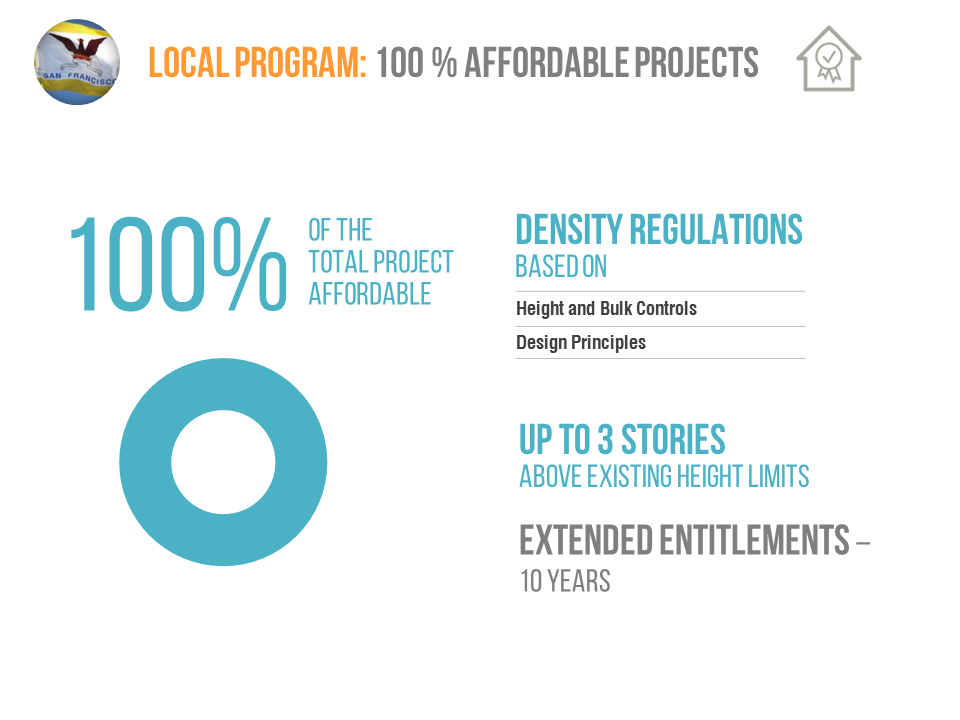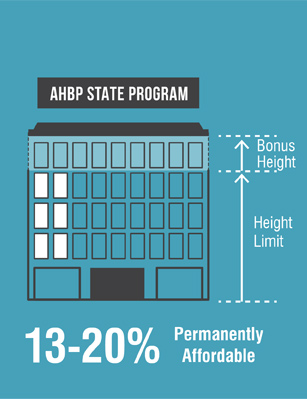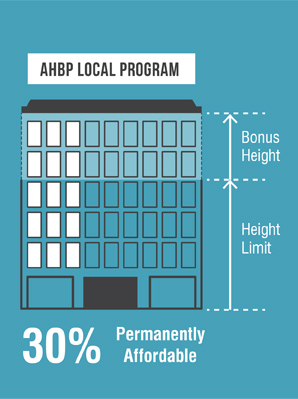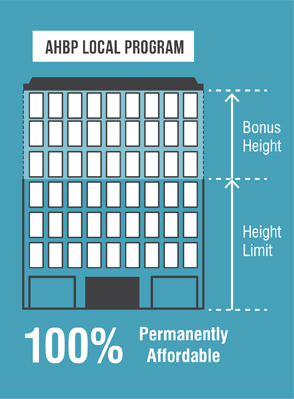Affordable Housing Bonus Program (AHBP)
Latest Updates
On July 29, 2016, Mayor Ed Lee signed the 100% Affordable Housing Bonus Ordinance into law.
Design Guidelines (PDF) for AHBP 100% Affordable Projects were also adopted.
October 2017: Informational Packet and Application for the 100% AHBP are now available
What is the Affordable Housing Bonus Program (AHBP)?
The AHBP is a program to increase the amount of affordable housing built in San Francisco. The program offers housing developers incentives, including inceased density and height, in return for building more permanently affordable homes into their projects.
AHBP offers several options, indicated as follows (click on the program name for details):
The Legislation
Follow changes to the legislation as it develops; this includes links to the case reports, proposed legislation, environmental review and related documents.
FAQs – Learn More
Some frequently asked questions about the program, such as:
Who is affordable housing for?
Who does the program work?
Etc.
Studies and Background Information
Read our consultant studies and background reports and documents.
Community Meetings and Events
List of recent community and stakeholder meetings, including materials presented. Includes a webinar, posters and presentations.
In the News
Read news articles related to the AHBP
Public Comment
Ongoing community input is welcome. Comments received will be shared with all decision-making bodies.
Contact
Program Manager
Paolo Ikezoe, Planner
415-575-9137
Paolo.Ikezoe@sfgov.org
Currently
The current program target for permanently affordable is 12%, with no bonus height.
The State AHBP
The State AHBP incorporates one of the options available through the Inclusionary Housing Program. To participate in the State AHBP, projects must include 12 percent on-site affordable housing units and up to an additional eight percent affordable housing units on-site for very low-, low- or moderate-income households. These projects will be offered specific incentives: an increased density bonus and up to two additional stories, but only when it is necessary to accommodate increased density. Incentives are offered on a graduated scale, commensurate with the amount of affordable housing included.
This program is referenced as ‘The State Program’ because it is intended to locally implement the State Density Bonus Law. Under this program, projects cannot exceed a 35 percent increase in potential residential density.

The Local AHBP
The Local AHBP will offer incentives to project sponsors that elect to provide 30 percent or more affordable housing units on-site. Of this 30 percent, 12 percent must be permanently affordable to low- and moderate-income households and 18 percent permanently affordable to middle-income households. Learn more about the definition of income levels here. If a project has nine or fewer housing units it is not subject to inclusionary housing requirements; therefore it must include a minimum of 30 percent of units affordable to middle-income households.
Projects that include 30 percent or more affordable units for low and middle-income households will be able to build more residential units and up to an additional two stories than currently allowed under existing zoning regulations. Two-bedroom units must make up a minimum of 40 percent of the total number of housing units in the building. The Local AHBP does not have a minimum housing unit threshold.

AHBP for 100% Affordable Projects
The Local AHBP includes special incentives for 100% affordable housing developments. These projects are generally built by non-profit developers, and usually require public subsidies. The AHBP is available to such projects which provide housing to households making 80% of AMI or less. Learn more about the definition of income levels here.
Projects with 100 percent affordable units will be able to build more residential units and up to three additional stories of residential development than currently allowed under existing zoning regulations.




